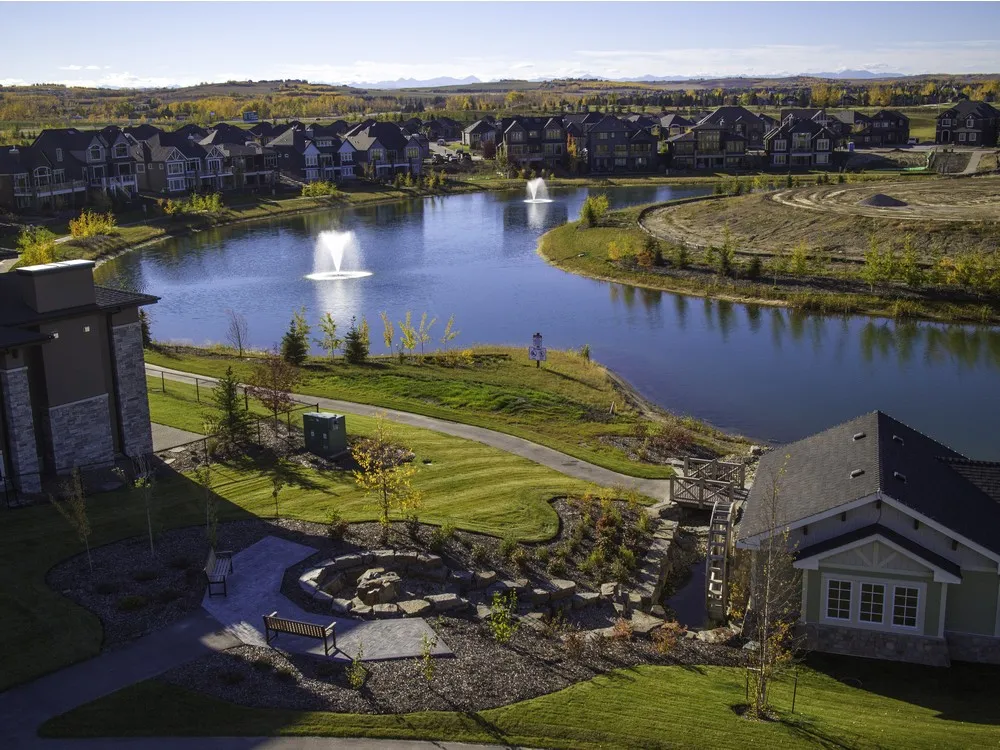Stormwater is no longer just a municipal checkbox. On the prairies (Winnipeg, Calgary, Saskatoon, and similar continental climates) two realities shape site behaviour and design: deep frost & spring thaw and frequent high-intensity convective storms (short, heavy thunderstorms). Under-designing for any one of these leaves a project exposed to cost overruns, delayed occupancy, withheld securities, and reputational risk. For dense infill, reliable solutions focus on surface retention (ponds), underground storage tanks/chambers, and hybrid systems, each with distinct cost, yield and long-term operational trade-off’s.
Cold-prairie facts that change design choices
- Spring thaw / snowmelt pulses create large seasonal runoff volumes when soils are saturated.
- High-intensity thunderstorms generate short-duration peak flows that can exceed historical rainfall assumptions and overwhelm local conveyance or on-site storage.
- Surface retention ponds are robust and passive for managing peak flows and improving water quality, but they use developable area and require embankment/grading works.
- Underground tanks/chambers preserve unit yield but add capital cost, pumps/controls, frost-protection needs and lifecycle maintenance obligations.
- Small urban measures (green roofs, planter boxes, permeable pavers) help water quality and reduce small-storm peaks but rarely remove the need for bulk storage on dense infill sites.
Key technical implications for servicing and approvals
- Model snowmelt and short-duration storms: hydrographs must reflect spring thaw and the 5 to 120-minute convective storms that drive peak flows and pipe sizing.
- Peak control sizing: systems sized only for historical rainfall are often under-sized for convective peaks. Increase peak capacity or include emergency spill routing.
- Retention ponds: provide passive detention and treatment and perform well in winter, but they reduce buildable land and require setbacks, embankment design and maintenance planning.
- Underground tanks & chambers: require rapid-fill design considerations, pump redundancy, alarm telemetry and frost protection for mechanicals.
- Water quality in winter: de-icing salts and winter maintenance increase pollutant loads. Include forebays, sumps and treatment inserts sized for cold-climate operation.
- Overflow routing & easements: define overflow paths for extreme events and secure easements if flows cross adjacent properties or municipal corridors.
- Scour & conveyance detail: high-intensity flows increase velocities; design headwalls, riprap and forebays to dissipate energy and trap sediment.
Practical design approaches (developer lens)
- Use a retention/tank baseline: size storage for spring thaw and short-duration storm scenarios as the default design approach.
- Compare surface pond vs underground tank vs hybrid: evaluate impact on unit yield, capital cost, and ongoing O&M.
- Design ponds for winter performance: address embankment stability, frozen storage geometry and select vegetation tolerant of freeze/thaw cycles.
- Protect mechanicals from frost: specify heated enclosures or bury equipment below frost depth and design for redundancy.
- Provide robust water-quality measures: winter pollutant loads require properly sized treatment devices and maintenance access.
- Prioritise maintenance access & safety: include inspection ports, fenced edges and maintenance paths to meet municipal and insurance requirements.
- Budget and assign O&M: document who pays for sediment removal, pump servicing and seasonal checks before tender close.
Cost & yield trade-off’s — high level
- Surface retention pond
- Pros: lower capital $/m³ stored, passive operation, strong treatment potential.
- Cons: reduces developable area, requires grading/landscaping.
- Underground tanks / chambers
- Pros: preserves footprint and unit yield.
- Cons: higher capital, pumps/controls, higher O&M and eventual replacement costs.
- Hybrid (small tank + shallow pond/LID): Often the best balance for mid-density infill: smaller tank limits cost while a pond or forebay handles excess and improves treatment.
(Site specifics vary. Stormwater solutions on infill commonly change servicing budgets from a few percent to double-digit percentage increases when trunk upgrades or extensive storage are required.)
Approval & tendering implications
- Submit hydrographs that include spring thaw and short-duration storm scenarios and clearly show overflow routing and emergency release.
- Demonstrate winter readiness: frost protection for mechanicals, winter access for maintenance, and plans for ice/sediment management.
- Tender clarity: call out chamber bedding, pump specs, treatment inserts and allowances for excavation in frozen ground. Identify long-lead items early.
- Specs strategy: use performance criteria for treatment outcomes but be prescriptive on items that affect winter operation and safety (access hatches, minimum pump redundancy).
10-point cold-prairie stormwater checklist (actionable)
- Size storage using spring thaw + short-duration storm scenarios.
- Compare pond vs tank vs hybrid on $/m³, unit yield and O&M risk.
- Size outlets and orifices for rapid inflow rates to avoid surcharge.
- Design forebays and riprap for scour from high-velocity inflows.
- Specify pump systems with redundancy, alarm telemetry and frost protection.
- Identify long-lead items (chambers, pumps) and add procurement to the program.
- Secure emergency overflow routes and record easements if needed.
- Perform geotechnical analysis at proposed tank and pond footprints for frost and bearing suitability.
- Provide a clear O&M manual and maintenance covenant as part of tender deliverables.
- Quantify EMV for stormwater risks and include them in project contingency.
How InfraCor helps
- Rapid feasibility memo comparing pond vs tank vs hybrid for your lot, with impact on unit yield.
- Hydraulic modelling using spring-thaw and short-duration convective storm scenarios plus climate sensitivity cases.
- Contractor-ready drawings and winterized specifications for ponds, chambers, pumps and scour protection.
- Tender packages calling out rapid-fill conditions, long-lead items, frozen-ground allowances and clear performance specs.
- Construction resident engineering for excavation in frost, chamber installation, pump commissioning and spring performance checks.
- O&M manuals, seasonal verification and as-built deliverables to support securities release.
Final Thoughts
Effective stormwater management on the prairies isn’t just an engineering exercise. It’s a business-critical decision that directly affects project yield, municipal approval timelines, construction costs, and long-term maintenance obligations. Developers who plan early, evaluate the right storage options, and design for both spring melt and high-intensity storms can protect profitability while avoiding costly redesigns or municipal delays. At InfraCor, our role is to help you balance these technical realities with your project’s financial and land-use goals, delivering stormwater solutions that satisfy regulators and maximize development potential.

